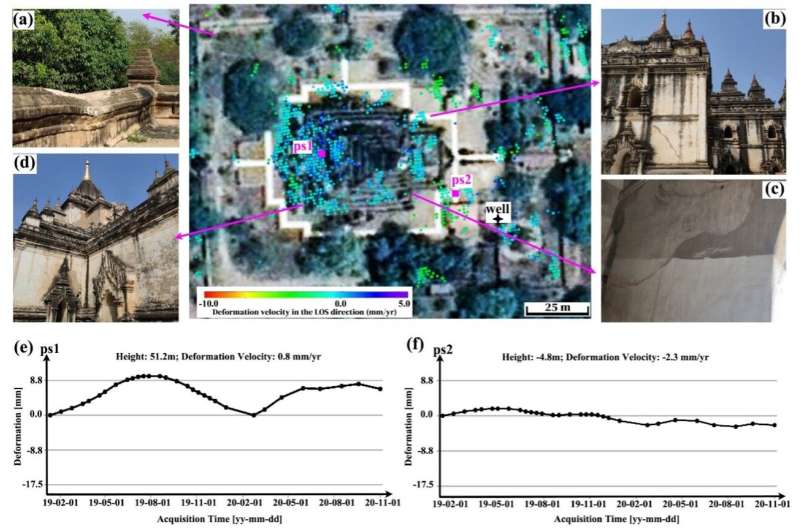Structural instability observed from InSAR measurements of the Gawdawpalin Pagoda. Credit: AIR
As a UNESCO World Heritage site, Bagan in Myanmar is home to more than 2, 200 structures, including pagodas and temples constructed from the 10th to the 14th centuries.
However, its age, combined with the surface subsidence and earthquakes over the region have posed great threats to the stability of the historic monuments and iconic pagodas at the vast site. Thus, the monitoring of landscape surface subsidence and vulnerability of the monuments is crucial to the protection and sustainable management of the Bagan heritage site.
A research team led by Prof. Chen Fulong from the International Research Center of Big Data for Sustainable Development Goals (CBAS) and the Aerospace Information Research Institute (AIR) of the Chinese Academy of Sciences (CAS) has pinpointed several hotspots and pagodas with displacement anomalies linked to land cover change and previous earthquakes by using Interferometric Synthetic Aperture Radar (InSAR) approaches.
The study was published in the International Journal of Digital Earth.
InSAR is a technique for mapping ground deformation using radar images of the Earth's surface collected from orbiting satellites. The noninvasive technology is a powerful tool to assess the vulnerability over the valuable heritage structures.
The team applied high-resolution TerraSAR-X imagery acquired from 2019–2020 for deformation monitoring based on the small baseline subset and persistent scatterer InSAR approaches.
The combination of the two multi-temporal SAR interferometry approaches satisfies the two-scale monitoring requirements from landscapes to monuments, particularly for large-scale world heritage sites.
"The non-contact monitoring method has potential when traditional methods using field accessibility and surveillance are constrained," said Prof. Chen.
More information: Fulong Chen et al, Remote sensing-based deformation monitoring of pagodas at the Bagan cultural heritage site, Myanmar, International Journal of Digital Earth (2022). DOI: 10.1080/17538947.2022.2062466
Provided by Chinese Academy of Sciences
























